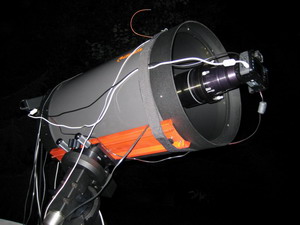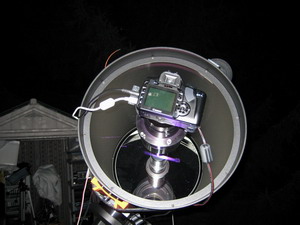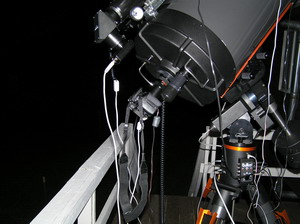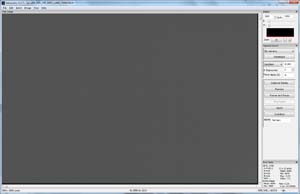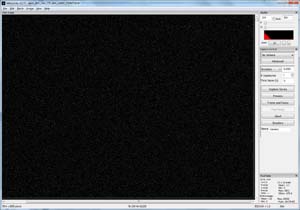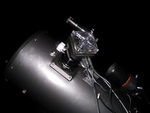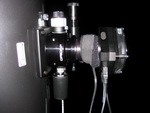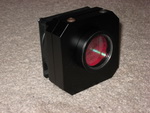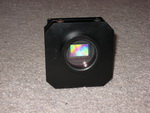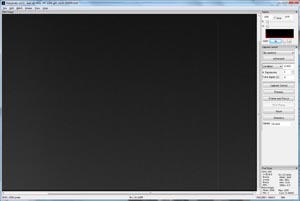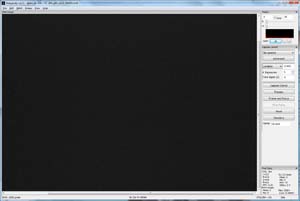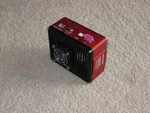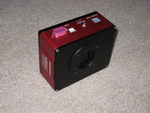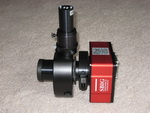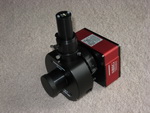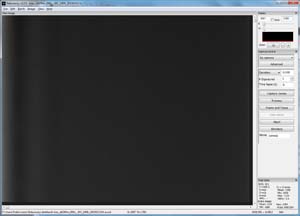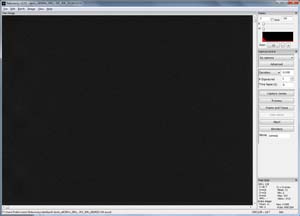Imaging Equipment - Cameras
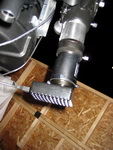 My first camera for astrophotography was Meade DSI, the first model with
color sensor. I bought it soon after it was released in the spring 2005.
This is a small, non-cooled camera with Sony Super HAD Color CCD Sensor
sensor with 510x492 pixels 9.6x7.5 microns each. It came with the
software necessary to acquire and process images. I used it with
Celestron C9.25 SGT as an imaging scope with Celestron f6.3 focal
reducer. It was fun, but the results were not that great - I think both
due to mine and camera limitations. Examples of my images with DSI are
M27 and
M57. Field of view at
f10 was quite small (11'x9') with image scale of 1.3"/pixel. I didn't use DSI
as the main imaging camera long, but it turned out to be an excellent
guiding camera, as as such it was used until the end of 2009, when it
was replaced buy more sensitive StalightXpress Lodestar.
My first camera for astrophotography was Meade DSI, the first model with
color sensor. I bought it soon after it was released in the spring 2005.
This is a small, non-cooled camera with Sony Super HAD Color CCD Sensor
sensor with 510x492 pixels 9.6x7.5 microns each. It came with the
software necessary to acquire and process images. I used it with
Celestron C9.25 SGT as an imaging scope with Celestron f6.3 focal
reducer. It was fun, but the results were not that great - I think both
due to mine and camera limitations. Examples of my images with DSI are
M27 and
M57. Field of view at
f10 was quite small (11'x9') with image scale of 1.3"/pixel. I didn't use DSI
as the main imaging camera long, but it turned out to be an excellent
guiding camera, as as such it was used until the end of 2009, when it
was replaced buy more sensitive StalightXpress Lodestar.
Unfortunately I had very little
time to pursue astrophotography between the fall 2005 and the Spring 2007 when I
started again - this time with CGE1400 and Canon Digital Rebel XTi.
Canon XTi was a Christmas gift for my wife Ewa and I was allowed to use
it in the night
![]() . The
results were much better - partly due to better equipment, partly due to
more experience, and partly due to the fact I started autoguiding.
Imaging with Canon XTi was quite successful, and it convinced me that I
am going in a good direction. Canon XTi sensor is 3,904x2,598 5.7 micron
pixels, much bigger than DSI. Examples of images with Xti are
M64,
M13,
Veil,
Veil Complex mosaic,
M31 and
M74.One disadvantage
of Canon XTi is that it has a built in filter reducing sensitivity in
the red part of the spectrum, it is done to make the sensor mimic human
eye as much as possible. Many nebulae are very bright in red part due to
Hα emission (656nm) so it is best to remove the
filter. I didn't want to harm my wife's main camera so in December 2007
I got Canon 40D with the original IR/UV filter replaced
with astronomical UV/IR filter. I bought the modified camera form
Hutech.
40D is better than XTi in one more aspect, it has 14 bit ADC
(Analog-to-Digital-Converter) unit with 16,536 levels versus 12 bit ADC
unit in XTi (4,096 levels), this gives better dynamic range for imaging.
Pleiades were the first object photographed with 40D, but since it
is still my active imaging camera there are many more examples:
M42,
Cone Nebula,
Horsehead,
Pelican Nebula (narrowband,
Hubble Palette) and
IC1318. I use this camera with C14 most often, it can image at
several different scales depending on optical configuration: 113'x75'
with 1.7"/pixel (Hyperstar),
25'x19' with 0.5"/pixel (Celestron f6.3 reducer) or 20'x15' with
0.4"/pixel (TS SCT 0.8 reducer). The
software used for capturing images is Nebulosity. Two pictures on the
right below show bias and dark frame (dark frame with bias subtracted).
Bias average pixel value is 4,094 and it forms a narrow peak on the
histogram. To the contrary, dark frame shows significant amount of dark
current spread over wide "mountain" on the left of the histogram. This
is to be expected for uncooled sensor. The optimal data reduction
strategy for this camera is to apply bias and then dark frame, and
keeping a library of dark frames shot in different temperatures (usually
10ºF apart). The last camera in the DSLR chain is
self-modified Canon T2i. I bought just a body and I
have removed the red-attenuating filters myself. It is being used the
same way Canon 40D is, usually on C14 in Hyperstar mode or with Orion
10" Newtonian. Canon 40D is more often used with lenses piggybacked on
the top of Orion 10" Newtonian.
. The
results were much better - partly due to better equipment, partly due to
more experience, and partly due to the fact I started autoguiding.
Imaging with Canon XTi was quite successful, and it convinced me that I
am going in a good direction. Canon XTi sensor is 3,904x2,598 5.7 micron
pixels, much bigger than DSI. Examples of images with Xti are
M64,
M13,
Veil,
Veil Complex mosaic,
M31 and
M74.One disadvantage
of Canon XTi is that it has a built in filter reducing sensitivity in
the red part of the spectrum, it is done to make the sensor mimic human
eye as much as possible. Many nebulae are very bright in red part due to
Hα emission (656nm) so it is best to remove the
filter. I didn't want to harm my wife's main camera so in December 2007
I got Canon 40D with the original IR/UV filter replaced
with astronomical UV/IR filter. I bought the modified camera form
Hutech.
40D is better than XTi in one more aspect, it has 14 bit ADC
(Analog-to-Digital-Converter) unit with 16,536 levels versus 12 bit ADC
unit in XTi (4,096 levels), this gives better dynamic range for imaging.
Pleiades were the first object photographed with 40D, but since it
is still my active imaging camera there are many more examples:
M42,
Cone Nebula,
Horsehead,
Pelican Nebula (narrowband,
Hubble Palette) and
IC1318. I use this camera with C14 most often, it can image at
several different scales depending on optical configuration: 113'x75'
with 1.7"/pixel (Hyperstar),
25'x19' with 0.5"/pixel (Celestron f6.3 reducer) or 20'x15' with
0.4"/pixel (TS SCT 0.8 reducer). The
software used for capturing images is Nebulosity. Two pictures on the
right below show bias and dark frame (dark frame with bias subtracted).
Bias average pixel value is 4,094 and it forms a narrow peak on the
histogram. To the contrary, dark frame shows significant amount of dark
current spread over wide "mountain" on the left of the histogram. This
is to be expected for uncooled sensor. The optimal data reduction
strategy for this camera is to apply bias and then dark frame, and
keeping a library of dark frames shot in different temperatures (usually
10ºF apart). The last camera in the DSLR chain is
self-modified Canon T2i. I bought just a body and I
have removed the red-attenuating filters myself. It is being used the
same way Canon 40D is, usually on C14 in Hyperstar mode or with Orion
10" Newtonian. Canon 40D is more often used with lenses piggybacked on
the top of Orion 10" Newtonian.
The next step was to get a second dedicated color imaging camera: QHY8 from CCD-Labs, necessary if I wanted to use my both imaging scopes simultaneously. QHY8 is a non-regulated cooled camera designed for astrophotography. It uses APS-C size sensor (Sony ICX453AQ Progressive Scan APS CCD) once used in Nikon DSLR with 3,032x2,016 7.8 micron pixels. It has very low dark current, especially that the sensor is cooled, but requires different sets of darks for different temperatures since it is not regulated. I prepare sets of darks during cloudy nights approximately 10ºF apart and then use them as long as there are no obvious new hot pixels on the images, when I redo the sets. To assure maximum dynamic range I set camera gain at 0 and offset at 130. This is an excellent astro camera, highly recommended. I use most with Orion 10" Newtonian, where it produces field of view 68'x45' with 1.3"/pixel. Image examples are M104, M20, M16, Crescent Nebula (narrowband, Hubble Palette), Cocoon Nebula and NGC2403. QHY8 has sometimes problem with the front optical windows fogging over in humid nights. The easiest fix is to heat up nose part (see pictures below) and store camera in a sealed Ziploc bag with a desiccant. Two pictures on the right below show bias and dark frame (dark frame with bias subtracted). Bias average pixel value is 1,907 and it forms a very narrow peak on the histogram, however there is a column of higher-biased pixels. Dark frame (bias corrected) shows almost no dark current with extremely narrow peak and average pixel value of 5. There are some hot pixels in the frame, but relatively few. Therefore the optimal data reduction strategy for this camera is to apply bias and then hot pixel map. It clearly shows the advantage of low noise cooled sensor. This camera was replaced with self-modified Canon T2i.
The newest member of my collection is SBIG ST-8300M
monochromatic camera. It has regulated chip temperature and very
sensitive low noise Kodak KAF-8300 sensor. I am planning to start LRGB
imaging with this camera, and do higher resolution narrowband imaging.
With C14 it can image at several different scales depending on optical
configuration: 92'x70' with 1.6"/pixel (Hyperstar), 25'x20' with
0.5"/pixel (Celestron f6.3 reducer) or 20'x15' with 0.4"/pixel (TS SCT
0.8 reducer), with Orion 10" it will yield 52'x39' with 0.9"/pixel.
Sensor size (18.1x13.7mm) is very similar to APS-C, but slightly smaller
and more square. There are no image examples yet!![]() Two pictures on the right below show bias and dark frame (dark
frame with bias subtracted). Bias average pixel value is 1,110
and it forms a very narrow peak on the histogram. Dark frame
(bias corrected) shows less dark current than in 40D but a bit
more than with QHY8, which is expected since Kodak sensors are
known to be have more dark current than Sony ones. There are
some hot pixels in the frame, spread mildly in the histogram.
The optimal data reduction strategy for this camera is to apply
bias and then dark frame, but only one is needed since the
temperature is controlled. Here are the examples of images
produced with SBIG ST-8300M: the first were
NGC5005 luminance and
NGC5005 LRGB,
more recent are
M1, NGC2392,
M27 and
M51.
Two pictures on the right below show bias and dark frame (dark
frame with bias subtracted). Bias average pixel value is 1,110
and it forms a very narrow peak on the histogram. Dark frame
(bias corrected) shows less dark current than in 40D but a bit
more than with QHY8, which is expected since Kodak sensors are
known to be have more dark current than Sony ones. There are
some hot pixels in the frame, spread mildly in the histogram.
The optimal data reduction strategy for this camera is to apply
bias and then dark frame, but only one is needed since the
temperature is controlled. Here are the examples of images
produced with SBIG ST-8300M: the first were
NGC5005 luminance and
NGC5005 LRGB,
more recent are
M1, NGC2392,
M27 and
M51.
